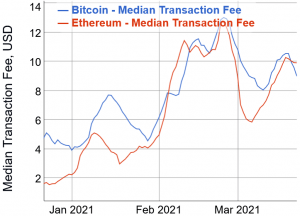The discussion over the Ethereum (ETH) network’s high fees continue, with many looking at incoming Ethereum improvement proposals (EIPs) and layer 2 (L2) projects as potential solutions – but the much-talked-about EIP-1559 is not it, said yet another analyst.
While Ethereum’s adoption has seen a massive growth, with the rise of decentralized finance (DeFi), stablecoins, and non-fungible tokens (NFTs), fees have shot up to new highs in early 2021, due to network congestion and sharp price increase.
Transaction fees now make up 50% of Ethereum miner revenue, said Nate Maddrey, a Research Analyst at crypto intelligence firm Coin Metrics, but the fee structure is set to change with the inclusion of EIP-1559 in the upcoming London hard fork, expected this July, bringing automatic setting of fees and token burn mechanism.
But will this EIP “fix today’s high gas prices and make Ethereum transaction fees significantly less expensive? The short answer is probably not,” according to the analyst.
Fees are fundamentally a scalability problem, and they will stay high as long as there’s high competition for block space. “If Ethereum can only process a few hundred transactions (on average) per block, there’s going to continue to be high fees as long as [decentralized app] usage keeps increasing,” he said.
According to him, what EIP-1559 will do is help improve the user experience, reduce gas fees variance, and make fees more predictable. Instead of a user-specified gas price, Ethereum transactions will have a base fee (algorithmically-computed price per unit of gas); a new block target size mechanism will keep blocks from consistently reaching maximum capacity, and instead of getting paid to miners, the base fee will get burned, while senders can tip the miners, Maddrey explained.
It’s the L2 solutions and ultimately Ethereum 2.0 that will be needed to truly reduce transaction fees over the long-term, said Maddrey.
As reported, Tim Roughgarden, an American computer scientist and a Professor of Computer Science at Columbia University, also argued that “no transaction fee mechanism, EIP-1559 or otherwise, is likely to substantially decrease average transaction fees; persistently high transaction fees is a scalability problem, not a mechanism design problem.”
Bitcoin, Ethereum median transaction fee chart:

At the time of writing (13:40 UTC), ETH trades at USD 1,714 and is down by almost 4% in a day and 4.3% in a week. The price is down by 11% in a month. It rallied by almost 1,300% in a year.
___
Learn more:
– Ethereum Moves Ahead With Plans for Earlier Transition to Proof-of-Stake
– Sushi is Expanding to Avalanche While Ethereum Camp Fights High Fees
– Ethereum Developers On Why They Don’t See Cardano & Binance Chain As Rivals
– Solana Founder On Critical DeFi Challenges and How To Fix Them
– Ethereum Fans Brag About All-Time High Fees As L2 Solution Coming
– What’s in Store for Ethereum in 2021?
